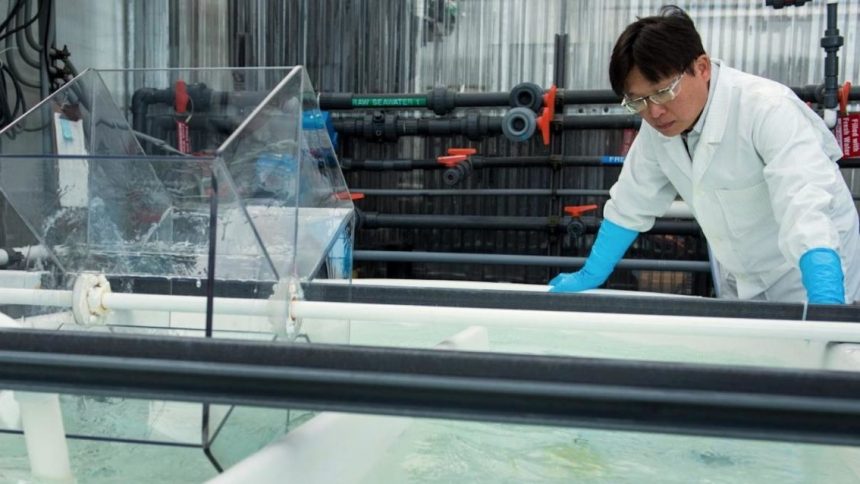This story was originally published by Yale 360 and is reproduced here as part of the Climate Desk collaboration. Can metals that naturally occur in seawater be mined, and can they be mined sustainably? A company in Oakland, California, says yes. And not only is it extracting magnesium from ocean water — and from waste brine generated by industry — it is doing it in a carbon-neutral way. Magrathea Metals has produced small amounts of magnesium in pilot projects, and with financial support from the U.S. Defense Department, it is building a larger-scale facility to produce hundreds of tons of the metal over two to four years. By 2028, it says it plans to be operating a facility that will annually produce more than 10,000 tons. Magnesium is far lighter and stronger than steel, and it’s critical to the aircraft, automobile, steel, and defense industries, which is why the government has bankrolled the venture. Right now, China produces about 85 percent of the world’s magnesium in a dirty, carbon-intensive process. Finding a way to produce magnesium domestically using renewable energy, then, is not only an economic and environmental issue, it’s a strategic one. “With a flick of a finger, China could shut down steelmaking in the U.S. by ending the export of magnesium,” said Alex Grant, Magrathea’s CEO and an expert in the field of decarbonizing the production of metals. “China uses a lot of coal and a lot of labor,” Grant continued. “We don’t use any coal and [use] a much lower quantity of labor.” The method is low cost in part because the company can use wind and solar energy during off-peak hours, when it is cheapest. As a result, Grant estimates their metal will cost about half that of traditional producers working with ore. Magrathea — named after a planet in the hit novel The Hitchhiker’s Guide to the Galaxy — buys waste brines, often from desalination plants, and allows the water to evaporate, leaving behind magnesium chloride salts. Next, it passes an electrical current through the salts to separate them from the molten magnesium, which is then cast into ingots or machine components. While humans have long coaxed minerals and chemicals from seawater — sea salt has been extracted from ocean water for millennia — researchers around the world are now broadening their scope as the demand for lithium, cobalt, and other metals used in battery technology has ramped up. Companies are scrambling to find new deposits in unlikely places, both to avoid orebody mining and to reduce pollution. The next frontier for critical minerals and chemicals appears to be salty water, or brine.
A technician pours a magnesium ingot at the Magrathea Metals facility in Oakland, California. Alex Grant Brines come from a number of sources: much new research focuses on the potential for extracting metals from briny wastes generated by industry, including coal-fired power plants that discharge waste into tailings ponds; wastewater pumped out of oil and gas wells — called produced water; wastewater from hard-rock mining; and desalination plants. Large-scale brine mining could have negative environmental impacts — some waste will need to be disposed of, for example. But because no large-scale operations currently exist, potential impacts are unknown. Still, the process is expected to have numerous positive effects, chief among them that it will produce valuable metals without the massive land disturbance and creation of acid-mine drainage and other pollution associated with hard-rock mining.
According to the Brine Miners, a research center at Oregon State University, there are roughly 18,000 desalination plants, globally, taking in 23 trillion gallons of ocean water a year and either forcing it through semipermeable membranes — in a process called reverse osmosis — or using other methods to separate water molecules from impurities. Every day, the plants produce more than 37 billion gallons of brine — enough to fill 50,000 Olympic-size swimming pools. That solution contains large amounts of copper, zinc, magnesium, and other valuable metals. Disposing of brine from desalination plants has always been a challenge. In coastal areas, desal plants shunt that waste back into the ocean, where it settles to the sea floor and can damage marine ecosystems. Because the brine is so highly concentrated, it is toxic to plants and animals; inland desalination plants either bury their waste or inject it into wells. These processes further raise the cost of an already expensive process, and the problem is only growing as desal plants proliferate globally. Finding a lucrative and safe use for brine will help solve plants’ waste problems and, by using their brine to feed another process, nudge them toward a circular economy, in which residue from one industrial activity becomes source material for a new activity.
According to OSU estimates, brine from desalination plants contains $2.2 trillion worth of materials, including more than 17,400 tons of lithium, which is crucial for making batteries for electric vehicles, appliances, and electrical energy storage systems. In some cases, mining brine for lithium and other metals and minerals could make the remaining waste stream less toxic. Ingots comprised of magnesium drawn from seawater by Magrathea Metals. Magrathea Metals
For many decades manufacturers have extracted magnesium and lithium from naturally occurring brines. In California’s Salton Sea, which contains enough lithium to meet the nation’s needs for decades, according to a 2023 federal analysis, companies have drilled geothermal wells to generate the energy required for separating the metal from brines. And in rural Arkansas, ExxonMobil recently announced that it is building one of the largest lithium processing facilities in the world — a state-of-the-art facility that will siphon lithium from brine deep within the Smackover geological formation. By 2030, the company says it will produce 15 percent of the world’s lithium. Miners have largely ignored the minerals found in desalination brine because concentrating them has not been economical. But new technologies and other innovations have created more effective separation methods and enabled companies to focus on this vast resource. “Three vectors are converging,” said Peter Fiske, director of the National Alliance for Water Innovation at the Department of Energy’s Lawrence Berkeley National Laboratory in Berkeley. “The value of some of these critical materials is going up. The cost of conventional [open pit] mining and extraction is going up. And the security of international suppliers, especially Russia and China, is going down.“
There is also an emphasis on — and grant money from the Department of Defense, the Department of Energy, and elsewhere for — projects and businesses that release extremely low, zero, or negative greenhouse gas emissions and that can be part of a circular economy. Researchers who study brine mining believe the holy grail of desalination — finding more than enough value in its waste brine to pay for the expensive process of creating fresh water — is attainable. Improved filtering technologies can now remove far more, and far smaller, materials suspended in briny water. “We have membranes now that are selective to an individual ion,” said Fiske. “The technology [allows us] to pick through the garbage piles of wastewater and pick out the high-value items.” One of the fundamental concepts driving this research, he says, “is that there is no such thing as wastewater.”
NEOM, the controversial and hugely expensive futuristic city under construction in the Saudi Arabian desert, has assembled a highly regarded international team to build a desalination plant and a facility to both mine its waste for minerals and chemicals and minimize the amount of material it must dispose of. ENOWA, the water and energy division of NEOM, claims that its selective membranes — which include reverse and forward osmosis — will target specific minerals and extract 99.5 percent of the waste brine’s potassium chloride, an important fertilizer with high market value. The system uses half the energy and requires half the capital costs of traditional methods of potassium chloride production. ENOWA says it is developing other selective membranes to process other minerals, such as lithium and rubidium salts, from waste brine. The Brine Miner project in Oregon has created an experimental system to desalinate saltwater and extract lithium, rare earth, and other metals. The whole process will be powered by green hydrogen, which researchers will create by splitting apart water’s hydrogen and oxygen molecules using renewable energy. “We are trying for a circular process,” said Zhenxing Feng, who leads the project at OSU. “We are not wasting any parts.”…






